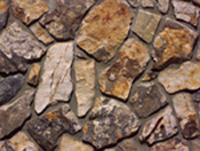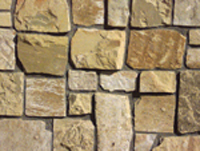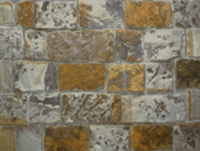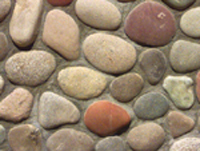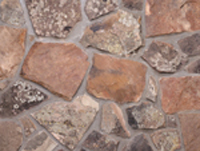Thin Brick and Thin-Cut Stone Take on Full-Dimension Masonry Products
Design Considerations
Styles
A wide variety of styles, shapes, and colors of thin stone and colors and styles of brick veneer, including straight edge and tumbled edge varieties, are available. In some veneers, stones are irregular in shape, in others they are more square or rectangular. Common styles include: mosaic, which features irregular or broken pieces; fieldstone, a random pattern of irregular stones; and ledge stone, a clean linear appearance with varying heights and depths. Mortar is used to adhere the product to the substrate; however, there are minimal mortar joints. Any openings should be filled and tooled with mortar to preserve the integrity of the installation system. The ashlar style, which involves large rectangular blocks of stone with square edges and even faces, has historically been used in monumental architecture. Manufacturers offer a wide variety of styles of thin stone and brick veneer, and will custom cut to an architect's specifications.
According to Jim Hambleton, National Sales Manager of Robinson Brick, a manufacturer of thin stone and brick veneer, there are regional favorites, but new trends in styles emerge regularly.
Thin masonry products give architects the flexibility to add depth of field by stepping the design out from the wall. Thin veneers lend themselves to accent bands, cornice lines, lintels, corbels, and a host of other facade enhancements, providing the assemblage does not exceed UBC weight limits for thin veneer.
|
||||||||
| Manufacturers offer thin stone veneer in a wide variety of textures, colors, shapes and styles. | ||||||||
Because manufacturers offer dozens of varieties of thin veneer stone in an array of colors and textures, architects are able to mix several types of stone together to produce distinctive and visually appealing structures at a cost far less than would have been possible with full-dimensional products. Natural thin veneer can also be trimmed during installation to meet precise detailing specifications.
Rodney Kazenske, a partner at Colorado Master Builders & Architects, used several thousand square feet of thin brick throughout a custom home in Greenwood Village, Colorado. "We used the thin brick in almost every room," says Kazenske. "It decreased the size of the foundation exponentially, and enabled us to run the wiring and install switches and outlets very easily, which would have been a logistical nightmare with standard brick. "The client wanted a heavy, masculine brick feel that Kazenske claims thin brick made financially and mechanically possible. "You can't distinguish it from the thicker standard brick-even when you knock on the wall," adds Kazenske, who installed thin brick over concrete board rather than drywall to give the veneer the appearance of more weight and mass. Kazenske is also partial to mixing types of thin veneer. In the great room, thin brick was complemented with thin limestone veneer around the fireplace. "It's a great way to incorporate brick and stone into the interiors of our homes," he says:
"Thin stone and brick veneers support a broad range of sustainability and energy-efficiency goals"
|
Cost Savings Implications
The lighter weight of thin veneer products translates to several advantages.
Installation.The installation of thin veneer is quicker and easier than with full veneer or full-dimension masonry, and can be done without shop drawings. A mason can haul and install far more material on an hourly and daily basis when using thin veneer-a significant factor as labor is a big part of the installation cost. "A full veneer crew of four can lay 40 to 60 feet a day. With thin veneer the same crew can complete 125 feet a day," says Hambleton. "There's a real opportunity to value engineer a project." Faster installation means more jobs thatthe same crew can take on in the same period of time-a significant concern as the supply of skilled masons continues to dwindle.
Transportation. As stone may be quarried and or fabricated in a different state or even on a different continent from where it will beultimately used, transportation costs are an increasingly important variable in specifying building materials. Because of its smaller size and weight, more thin veneer can be shipped per truckload. According to industry experts, a truck traveling from Denver to Atlanta can take 13,000 pieces of full-dimension brick, or 60,000 pieces of thin-veneer brick. The same truck can carry enough full-depth stone (typically fourinches deep) to cover 1,000 square feet of wall surface, or enough thin stone veneer to cover 4,000 square feet. Generally, that translates to a reduction in transportation costs by a factor of four.
Amount of Veneer Needed. Thin stone veneer typically comes packaged in large boxes that contain approximately 100 square feet of flats or approximately 100 linear feet of corners, and small boxes that contain five to ten square feet of flats or five linear feet of corners. Most products are packaged under the assumption that a ½-inch mortar joint will be used in installation.
The amount of thin veneer material needed for a project can be calculated via the following method:
Measure the width and height of areas to be covered (total square footage). Then estimate corners required by measuring the total height of the wall corners to be covered. This will equal the number of linear feet of thin veneer corners needed. Subtract 75 percent of the corner linear foot calculation from the total square feet to be covered. This will equal the number of square feet of flat pieces of veneer needed.
Architects should note that dry stacking the material will require about 30 percent more of the product. However, some products that are sold as "dry stack" or ledge stone already have the lack of a mortar joint figured in. Products that are ashlar or mosaic require additional material if the joint size is decreased.





